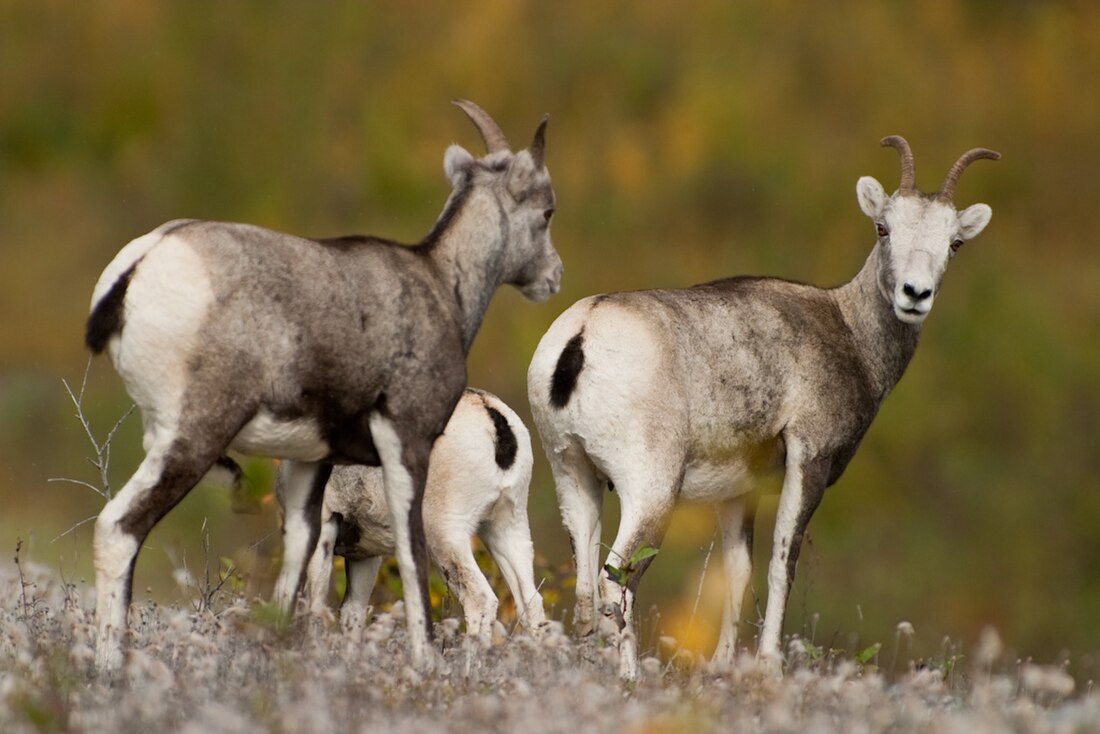Caprinae
Subfamily of mammals From Wikipedia, the free encyclopedia
The subfamily Caprinae,[1] also sometimes referred to as the tribe Caprini,[2] is part of the ruminant family Bovidae,[3] and consists of mostly medium-sized bovids. A member of this subfamily is called a caprine.[4]
This article needs additional citations for verification. (October 2015) |
| Caprinae Temporal range: | |
|---|---|
 | |
| Stone sheep (Ovis dalli stonei) in British Columbia, 2009 | |
| Scientific classification | |
| Domain: | Eukaryota |
| Kingdom: | Animalia |
| Phylum: | Chordata |
| Class: | Mammalia |
| Order: | Artiodactyla |
| Family: | Bovidae |
| Subfamily: | Caprinae J. E. Gray, 1821 |
| Tribes | |
Prominent members include sheep and goats, with some other members referred to as goat antelopes. Some earlier taxonomies considered Caprinae a separate family called Capridae (with the members being caprids), but now it is usually considered either a subfamily within the Bovidae, or a tribe within the subfamily Antilopinae of the family Bovidae, with caprines being a type of bovid.
Characteristics
Summarize
Perspective

Although most goat-antelopes are gregarious and have fairly stocky builds, they diverge in many other ways – the muskox (Ovibos moschatus) is adapted to the extreme cold of the tundra; the mountain goat (Oreamnos americanus) of North America is specialised for very rugged terrain; the urial (Ovis orientalis) occupies a largely infertile area from Kashmir to Iran, including much desert country. The Armenian mouflon (Ovis gmelini gmelini) is thought to be the ancestor of the modern domestic sheep (Ovis aries).
Many species have become extinct since the last ice age, probably largely because of human interaction. Of the survivors:
- Five are classified as endangered,
- Eight as vulnerable,
- Seven as of concern and needing conservation measures, but at lower risk, and
- Seven species are secure.
Members of the group vary considerably in size, from just over 1 m (3 ft) long for a full-grown grey goral (Nemorhaedus goral), to almost 2.5 m (8 ft 2 in) long for a musk ox, and from under 30 kg (66 lb) to more than 350 kg (770 lb). Musk oxen in captivity have reached over 650 kg (1,430 lb).[citation needed]
The lifestyles of caprids fall into two broad classes: 'resource-defenders', which are territorial and defend a small, food-rich area against other members of the same species; and 'grazers', which gather together into herds and roam freely over a larger, usually relatively infertile area.
The resource-defenders are the more primitive group: they tend to be smaller, dark in colour, males and females fairly alike, have long, tessellated ears, long manes, and dagger-shaped horns. The grazers (sometimes collectively known as tsoan caprids, from the Hebrew tso'n meaning sheep and goats) evolved more recently. They tend to be larger, highly social, and rather than mark territory with scent glands, they have highly evolved dominance behaviours. No sharp line divides the groups, but a continuum varies from the serows at one end of the spectrum to sheep, true goats, and musk oxen at the other.
Evolution
Summarize
Perspective

The goat-antelope, or caprid, group is known from as early as the Miocene, when members of the group resembled the modern serow in their general body form.[5] The group did not reach its greatest diversity until the recent ice ages, when many of its members became specialised for marginal, often extreme, environments: mountains, deserts, and the subarctic region.
The ancestors of the modern sheep and goats (both rather vague and ill-defined terms) are thought to have moved into mountainous regions – sheep becoming specialised occupants of the foothills and nearby plains, and relying on flight and flocking for defence against predators, and goats adapting to very steep terrain where predators are at a disadvantage.
Internal relationships of Caprinae based on mitochondrial DNA.[6]
| Bovidae |
| ||||||||||||||||||||||||||||||||||||||||||||||||||||||||||||||||||||||||||||||||||||
Species
Summarize
Perspective
Phylogeny based on Hassanin et al., 2009 and Calamari, 2021.[7][8]
Family Bovidae
- Subfamily Caprinae or Tribe Caprini
| Tribe or subtribe | Image | Genus | Species |
|---|---|---|---|
| Caprini or Caprina |
 |
Ammotragus (Blyth, 1840) |
|
 |
Arabitragus Ropiquet & Hassanin, 2005 |
| |
 |
Budorcas Hodgson, 1850 |
| |
 |
Capra Linnaeus, 1758 |
| |
 |
Hemitragus (Hodgson, 1841) |
| |
 |
Nilgiritragus Ropiquet & Hassanin, 2005 |
| |
 |
Oreamnos Rafinesque, 1817 |
| |
 |
Ovis Linnaeus, 1758 |
| |
 |
Pseudois Hodgson, 1846 |
| |
 |
Rupicapra Garsault, 1764 |
| |
 |
†Myotragus Bate, 1909 |
||
| Ovibovini or Ovibovina |
 |
Capricornis Ogilby, 1837 |
|
 |
Nemorhaedus Hamilton Smith, 1827 |
| |
 |
Ovibos Blainville, 1816 |
| |
| Pantholopini or Pantholopina |
 |
Pantholops Hodgson, 1834 |
|
Fossil genera
The following extinct genera of Caprinae have been identified:[9][10]
- Tribe Caprini
- Tribe Ovibovini
- Genus Bootherium †
- Bootherium bombifrons†
- Genus Euceratherium †
- Euceratherium collinum†
- Genus Makapania †
- Makapania broomi†
- Genus Megalovis †
- Genus Soergelia †
- Soergelia mayfieldi†
- Genus Tsaidamotherium †
- Tsaidamotherium brevirostrum†
- Tsaidamotherium hedini†
- Genus Bootherium †
- Unsorted
- †Benicerus
- †Boopsis
- †Capraoryx
- †Caprotragoides
- †Criotherium
- †Damalavus
- †Gallogoral
- †Lyrocerus
- †Mesembriacerus
- †Neotragocerus
- †Nesogoral
- †Norbertia
- †Numidocapra
- †Oioceros
- †Olonbulukia
- †Pachygazella
- †Pachytragus
- †Palaeoreas
- †Palaeoryx
- †Paraprotoryx
- †Parapseudotragus
- †Parurmiatherium
- †Praeovibos
- †Procamptoceras
- †Prosinotragus
- †Protoryx
- †Protovis
- †Pseudotragus
- †Qurliqnoria
- †Samotragus
- †Sinocapra
- †Sinomegoceros
- †Sinopalaeoceros
- †Sinotragus
- †Sivacapra
- †Sporadotragus
- †Tethytragus
- †Tossunnoria
- †Turcocerus
- †Urmiatherium
References
Wikiwand - on
Seamless Wikipedia browsing. On steroids.
